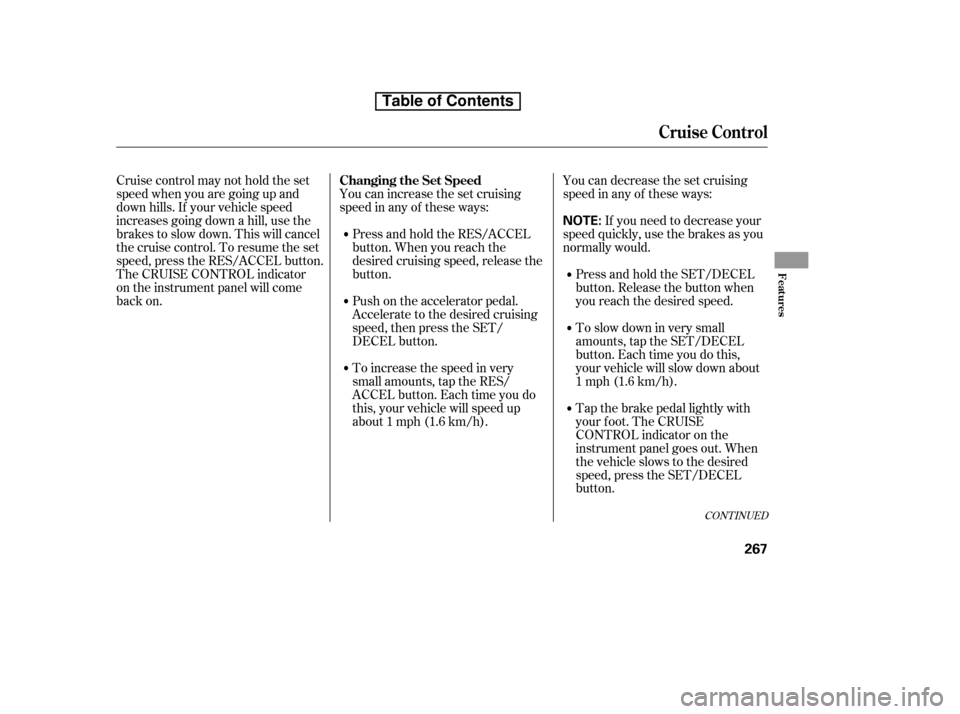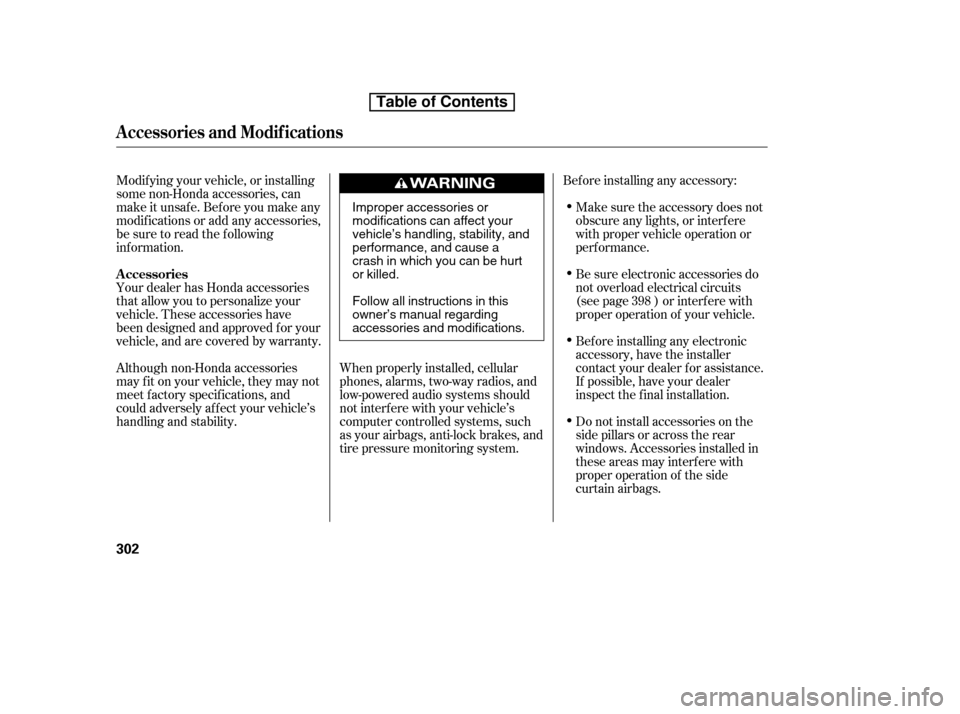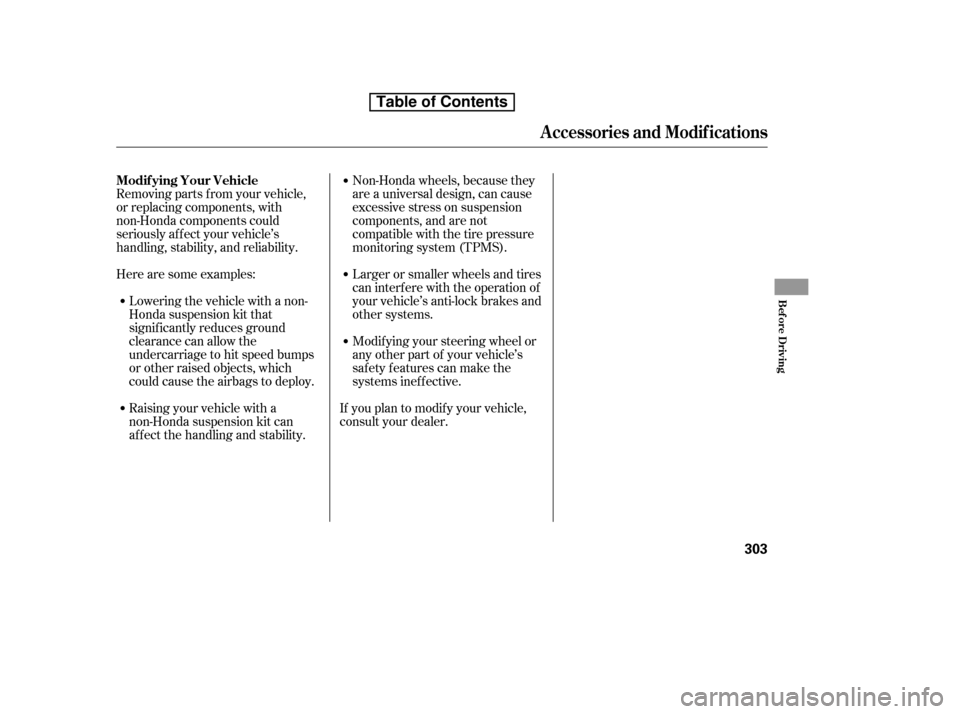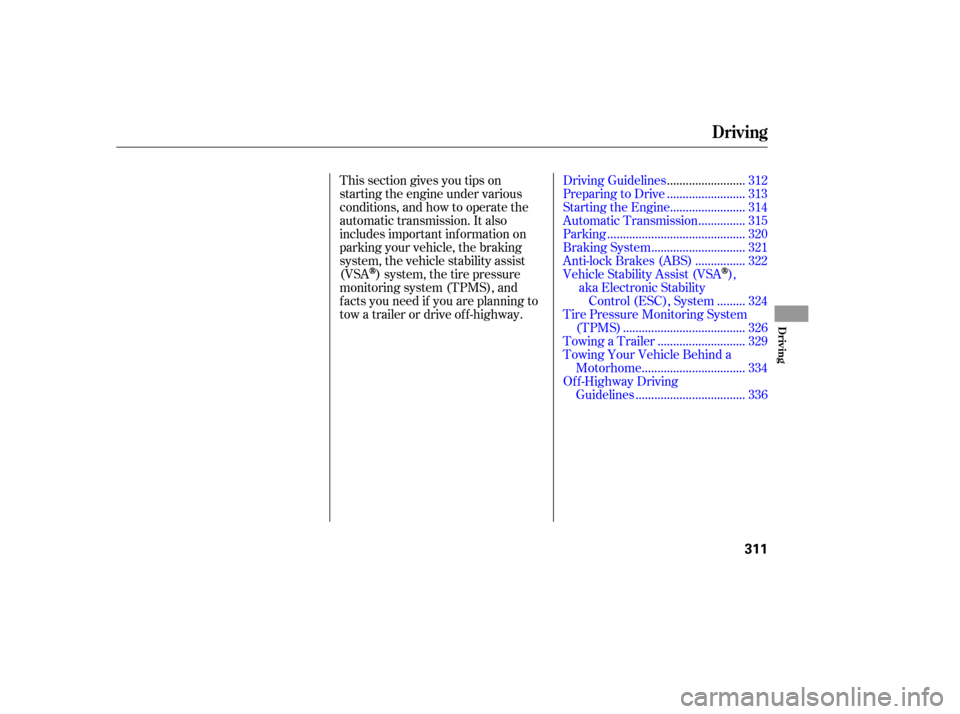2010 HONDA CR-V brakes
[x] Cancel search: brakesPage 1 of 441

CONT INUED
BatteryCharging System ...........................
Indicator . 62, 394
............................
Jump Starting . 390
..............................
Maintenance . 376
............................
Specif ications . 409
..............................
Bef ore Driving . 293
....................................
Belts,Seat .9,19
.........................
Beverage Holders . 119
......
Hands Free Link. 269
..................................
Booster Seats . 52
Brakes
...........
Anti-lock System (ABS) . 322 .............
Break-in, New Linings . 294
....................
Bulb Replacement . 363
...........................................
Fluid . 357
.........................................
Parking . 81
.................
System Indicator . 62, 396
..........................
System Design . 321
........................
Wear Indicators . 321
.............................
Braking System . 321
.................
Break-in, New Vehicle . 294
..
Brightness Control, Instruments . 79
Bulb Replacement
..........................
Back-up Lights . 363
..............................
Brake Lights . 363
................
Front Parking Lights . 362
........
Front Side Marker Lights . 362
.................................
Headlights . 359
.........
High-mount Brake Light . 364
.........
Rear Side Marker Lights . 363
............................
Specif ications . 409
............
Turn Signal Lights . 361, 363
..............................
Bulbs, Halogen . 359
....................................
Accessories . 302
ACCESSORY (Ignition Key
.......................................
Position) . 84
............
Accessory Power Sockets . 123
..................
Active Head Restraint . 103
....................
Additives, Engine Oil . 350
.......
Adjusting the Steering Wheel . 81
...........................
Advanced Airbags . 28
.............................
Airbag (SRS) . 10, 23
......
Air Conditioning System . 130, 135
.................................
Usage . 131, 136
.......................
Air Pressure, Tires . 371
.......................
Alcohol in Gasoline . 294
......................................
Antif reeze . 352
Anti-lock Brakes (ABS)
...............................
Indicator . 63, 322
...................................
Operation . 322
..............
Anti-thef t, Audio System . 258
.
Anti-thef t Steering Column Lock . 84
................................
Audio System . 143
.....
Auto Door Locking/Unlocking . 86
..........
Automatic Climate Control . 135
...
Automatic Seat Belt Tensioners . 21
.............
Automatic Speed Control . 266 ..............
Automatic Transmission . 315
..........................
Capacity, Fluid . 408
...............
Checking Fluid Level . 355
.....................................
D Mode . 317
.......................................
Shif ting . 315
Shif t Lever Position
...............................
Indicators . 315
................
Shif t Lever Positions . 316
....................
Shif t Lock Release . 319
......................
Auxiliary Input Jack . 257Bluetooth
3
Index
A
B
INDEX
I
Page 77 of 441

The instrument panel has many
indicators that give you important
inf ormation about your vehicle.
See page .
If this indicator comes on when the
engine is running, the battery is not
being charged. For more inf ormation,
see page .
The engine can be severely damaged
if this indicator f lashes or stays on
when the engine is running. For
more inf ormation, see page . This indicator comes on when you
turn the ignition switch to the ON
(II) position. It reminds you and your
passengers to f asten your seat belts.
A beeper also sounds if you have not
f astened your seat belt.
If you turn the ignition switch to the
ON (II) position bef ore f astening
your seat belt, the beeper sounds,
and the indicator f lashes. If you do
notfastenyourseatbeltbeforethe
beeper stops, the indicator stops
f lashing but remains on.
If your f ront passenger does not
f asten their seat belt, the indicator
comes on about 6 seconds af ter the
ignition switch is turned to the ON
(II) position.
This indicator has two f unctions:
Itcomesonwhenyouturnthe
ignition switch to the ON (II)
position. It is a reminder to check
the parking brake. A beeper
sounds if you drive with the
parking brake not f ully released.
Driving with the parking brake not
fully released can damage the
brakes and tires.
If it stays on after you have fully
released the parking brake while
the engine is running, or if it
comes on while driving, there
could be a problem with the brake
system. For more inf ormation, see
page .
2.
1.
395
394
394 396
Malf unction Indicator
Lamp
L ow Oil Pressure
Indicator
Charging System
Indicator
Seat Belt Reminder
Indicator
Parking Brake and
Brake System
Indicator
Instrument Panel Indicators
62
U.S. Canada
Table of Contents
Page 96 of 441

Push the lever under the steering
column all the way down.
Make any steering wheel adjustment
bef ore you start driving.
To apply the parking brake, push the
pedal down with your f oot. To
release it, push on the pedal again.
The parking brake indicator on the
instrument panel should go out when
the parking brake is fully released
(see page ). Move the steering wheel up or
down, and in or out, so it points
toward your chest, not toward
your f ace. Make sure you can see
the instrument panel gauges and
indicators.
1. 2.
62
CONT INUED
Parking Brake Steering Wheel A djustment
Parking Brake, Steering Wheel A djustment
Inst rument s and Cont rols
81
PARKING BRAKE PEDAL
Adjusting the steering wheel
position while driving may
cause you to lose control of the
vehicle and be seriously injured
inacrash.
Adjust the steering wheel only
when the vehicle is stopped.
Driving the vehicle with the parking
brake applied can damage the rear
brakes and hubs. A beeper will sound if
the vehicle is driven with the parking
brake on.
Table of Contents
Page 282 of 441

You can increase the set cruising
speed in any of these ways:You can decrease the set cruising
speed in any of these ways:
Press and hold the RES/ACCEL
button. When you reach the
desired cruising speed, release the
button.
To increase the speed in very
small amounts, tap the RES/
ACCEL button. Each time you do
this, your vehicle will speed up
about 1 mph (1.6 km/h).
Cruise control may not hold the set
speed when you are going up and
down hills. If your vehicle speed
increases going down a hill, use the
brakes to slow down. This will cancel
thecruisecontrol.Toresumetheset
speed, press the RES/ACCEL button.
The CRUISE CONTROL indicator
on the instrument panel will come
back on.
To slow down in very small
amounts, tap the SET/DECEL
button. Each time you do this,
your vehicle will slow down about
1 mph (1.6 km/h).
Press and hold the SET/DECEL
button. Release the button when
you reach the desired speed.
If you need to decrease your
speed quickly, use the brakes as you
normally would.
Push on the accelerator pedal.
Accelerate to the desired cruising
speed, then press the SET/
DECEL button.
Tap the brake pedal lightly with
your f oot. The CRUISE
CONTROL indicator on the
instrument panel goes out. When
the vehicle slows to the desired
speed, press the SET/DECEL
button.
CONT INUED
Changing the Set Speed
Cruise Control
Features
267
NOTE:
Table of Contents
Page 309 of 441

Help assure your vehicle’s f uture
reliability and perf ormance by paying
extra attention to how you drive
during the f irst 600 miles (1,000 km).Avoid full-throttle starts and rapid
acceleration.
Do not change the oil until the
scheduled maintenance time.
Avoidhardbrakingforthefirst
200 miles (300 km).
During this period:
You should also f ollow these
recommendations with an
overhauled or exchanged engine, or
when the brakes are replaced.
Do not tow a trailer. Your vehicle is designed to operate
on unleaded gasoline with a pump
octane number of 87 or higher. Use
of a lower octane gasoline can cause
a persistent, heavy metallic rapping
noise that can lead to engine damage.
In addition, in order to maintain good
perf ormance, f uel economy, and
emissions control, we strongly
recommend, in areas where it is
available, the use of gasoline that
does NOT contain manganese-based
f uel additives such as MMT.
Use of gasoline with these additives
may adversely af f ect perf ormance,
and cause the malfunction indicator
lamp on your instrument panel to
come on. If this happens, contact your authorized dealer f or service.
Some gasoline today is blended with
oxygenates such as ethanol or
MTBE. Your vehicle is designed to
operate on oxygenated gasoline
containing up to 10% ethanol by
volume and up to 15% MTBE by
volume. Do not use gasoline
containing methanol.
If you notice any undesirable
operating symptoms, try another
service station or switch to another
brand of gasoline.
We recommended using a quality
gasoline containing detergent
additives that help prevent fuel
system and engine deposits.
For f urther important f uel-related
inf ormation f or your vehicle, or
inf ormation on gasoline that does not
contain MMT, visit Owner Link at. In Canada, visit
f or additional
inf ormation on gasoline.
owners.honda.com
www.honda.ca
Break-in Period Fuel Recommendation
Break-in Period, Fuel Recommendation
294
Table of Contents
Page 317 of 441

Modif ying your vehicle, or installing
some non-Honda accessories, can
make it unsaf e. Bef ore you make any
modif ications or add any accessories,
be sure to read the f ollowing
inf ormation.Bef ore installing any accessory:
Make sure the accessory does not
obscure any lights, or interf ere
with proper vehicle operation or
perf ormance.
Bef ore installing any electronic
accessory, have the installer
contact your dealer for assistance.
If possible, have your dealer
inspect the f inal installation.
Do not install accessories on the
side pillars or across the rear
windows. Accessories installed in
theseareasmayinterferewith
proper operation of the side
curtain airbags.
Your dealer has Honda accessories
that allow you to personalize your
vehicle. These accessories have
been designed and approved f or your
vehicle, and are covered by warranty.
Although non-Honda accessories
may f it on your vehicle, they may not
meet f actory specif ications, and
could adversely af f ect your vehicle’s
handling and stability.
Be sure electronic accessories do
not overload electrical circuits
(see page ) or interf ere with
proper operation of your vehicle.
When properly installed, cellular
phones, alarms, two-way radios, and
low-powered audio systems should
not interf ere with your vehicle’s
computer controlled systems, such
as your airbags, anti-lock brakes, and
tire pressure monitoring system. 398
A ccessories and Modif ications
A ccessories
302
Improper accessories or
modifications can affect your
vehicle’s handling, stability, and
performance, and cause a
crash in which you can be hurt
or killed.
Follow all instructions in this
owner’s manual regarding
accessories and modifications.
Table of Contents
Page 318 of 441

Raising your vehicle with a
non-Honda suspension kit can
af f ect the handling and stability.
Removing parts f rom your vehicle,
or replacing components, with
non-Honda components could
seriously af f ect your vehicle’s
handling, stability, and reliability.
Herearesomeexamples:
Lowering the vehicle with a non-
Honda suspension kit that
signif icantly reduces ground
clearance can allow the
undercarriage to hit speed bumps
or other raised objects, which
could cause the airbags to deploy. Non-Honda wheels, because they
are a universal design, can cause
excessive stress on suspension
components, and are not
compatible with the tire pressure
monitoring system (TPMS).
Larger or smaller wheels and tires
can interf ere with the operation of
your vehicle’s anti-lock brakes and
other systems.
Modif ying your steering wheel or
any other part of your vehicle’s
safety features can make the
systems inef f ective.
If you plan to modif y your vehicle,
consult your dealer.
A ccessories and Modif ications
Modif ying Your Vehicle
Bef ore Driving
303
Table of Contents
Page 326 of 441

This section gives you tips on
starting the engine under various
conditions, and how to operate the
automatic transmission. It also
includes important inf ormation on
parking your vehicle, the braking
system, the vehicle stability assist
(VSA
) system, the tire pressure
monitoring system (TPMS), and
f acts you need if you are planning to
tow a trailer or drive off-highway. ........................
Driving Guidelines . 312
........................
Preparing to Drive . 313
.......................
Starting the Engine . 314
..............
Automatic Transmission . 315
...........................................
Parking . 320
.............................
Braking System . 321
...............
Anti-lock Brakes (ABS) . 322
Vehicle Stability Assist (VSA
),
aka Electronic Stability ........
Control (ESC), System . 324
Tire Pressure Monitoring System ......................................
(TPMS) . 326
...........................
Towing a Trailer . 329
Towing Your Vehicle Behind a
................................
Motorhome . 334
Of f -Highway Driving ..................................
Guidelines . 336
Driving
Driving
311